Well this week we have had to remember the throwing of the King, on this 4th of July celebration from our burrows, even though there were many private (mostly illegal, but quite impressive) fireworks displays in the area, but we also had several opportunities to look up at the sun and the moon.
First up, we heard from OCA Jonathan Hankey, who took advantage of the predicted ISS transit of the sun to be out and set up to capture it with his camera. Check out the stacked image of the ISS passing in front of the sun. The ISS appears as an object of about 1 arc-minute in angular size. Thanks for sharing that with us that great capture, Jonathan!
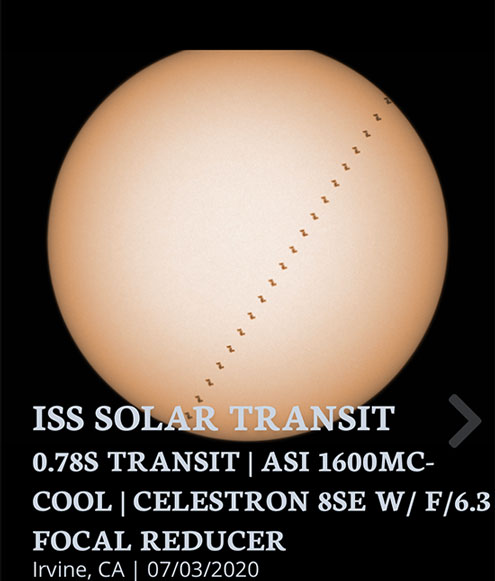 |
| ISS Solar Transit as seen on July 3 in southern California (Source: OCA Jonathan Hankey) |
Wow, so how do you know to go outside and try to see the transit? Well, various websites offer predictions for your particular location. In the screenshot below from transit-finder.com, you can see the details for the recent July 3 transit. You can check out the next observing opportunity for your own area. So you can see the predicted azimuth and altitude for observing the transit from the LA area, but pay special attention to the time of duration, which is listed as only 0.8 seconds. Hmm, you have got to be very lucky with your shutter activation or use a video camera.
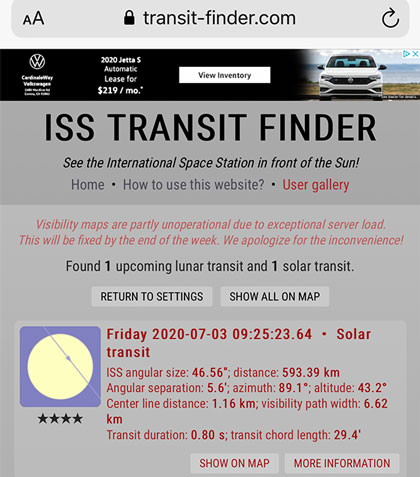 |
| Check out the next transit near your location (Source: www.transit-finder.org) |
Well, the ISS, and other satellites, pass in front of the moon as well. Here is an image of the ISS passing in front of the moon. Again the angular size of the ISS is just right around 1 arc-minute and you have a little more leeway in the time of transit, do don't forget about the moon either.
 |
| ISS transit of the moon are also visible and photographable (Source: www.americaspace.com) |
Now if you want to have even more time to click the shutter consider taking images of airplanes transiting in front of the sun or moon. It can be easier, or at least it was when there were a lot more planes up in the air. Here is a blast from the past, where I finally captured a plane in front of the moon. Getting this image just relies on waiting for the right moment and being at the right location for normal air traffic out of the local airports makes it easier than ISS transits. There were many near misses, but the shutter timing is not anywhere near as critical.
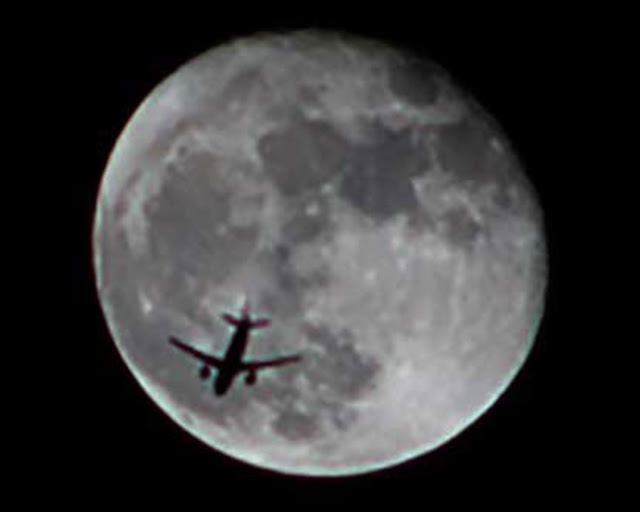 |
| My lucky shot of plane transiting the moon (Oct. 29, 2015) is easier to do (Source: Palmia Observatory) |
Ok, so as long as we are talking about the moon we should take advantage of the upcoming July 4 penumbral lunar eclipse, which we first took notice of from an email from Ventura County Astronomical Society (VCAS). As you can see the maximum eclipse occurs at 9:30 pm PDT. So here it is on July 4 and we can be out side and just look up at the moon.
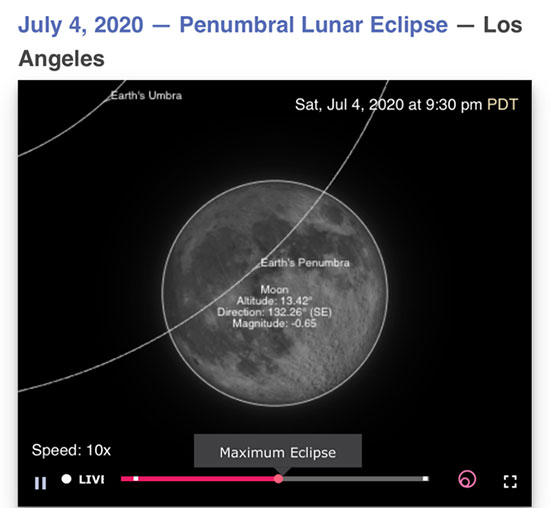 |
| Predicted time for maximum penumbral lunar eclipse (Source: www.timeanddate.com) |
So we see that the eclipse will darken a portion of the moon, but just in case you don't quite remember what a penumbral eclipse is, check out this screenshot from timeanddate.com. You can see that this expected eclipse is not going to be as apparent as would a more significant umbral eclipse, where the Earth's shadow more completely blocks out the moon from receiving any light from the sun.
 | |
|
As the moon moves about in its orbit, the eclipse ends at about 10:52 pm PDT. So our observing plan is go out and get an image at the point in time of maximum eclipse and then get another image after the eclipse ends.
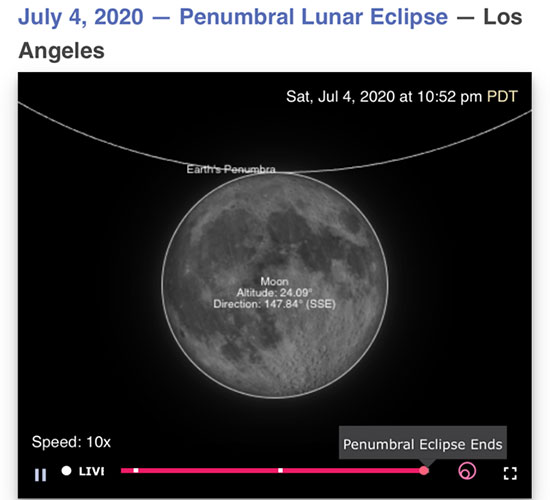 | |
|
We can get an idea of what to expect by looking at previous examples of penumbral eclipses. Check out this screenshot form EarthSky.com, where we can see how the brightness of the moon varies as the eclipse begins and ends.
 |
| Stacked images of recent penumbral lunar eclipse (Source: www.earthsky.org) |
So, now we have an idea about when and where to look, it is time to go outside and see what we can see. The eclipse actually started about an hour before 9:00, but the sky was still so bright and the moon so low on the horizon that I couldn't see the moon. But at 9:30 pm, the moon was high enough to be seen, just above the trees. There were so high light clouds in the area and the moon had a bit of a glow around it from them. But here is a 300 mm DSLR image of the moon at 9:30 pm. Hmm, I'm not quite able to make out much of a difference in lighting over the left hand portion of the image.
 |
| Image of the moon at 9:30 pm PDT with 300 mm, 1/1000 second DSLR (Source: Palmia Observatory) |
Now, the observing plan was to go back outside at 10:52 pm and take another image of the moon at the end of the eclipse. I was out there at the right time, but unfortunately, the image was not in focus and I didn't discover it until I came back inside. Hmm, there is still time to go back out and take a more focused image at 11:38 pm. Late, but better than never!. The high clouds seemed to be gone. The moon was higher in the sky and it should have appeared a bit brighter anyway because it was not close to the horizon. So for the same 1/1000 shutter exposure you can see it is indeed brighter. Hmm, well for this first attempt at a penumbral lunar eclipse, I couldn't see much difference in brightness, but at least it was nice to get outside and look up and try to gets some photos.
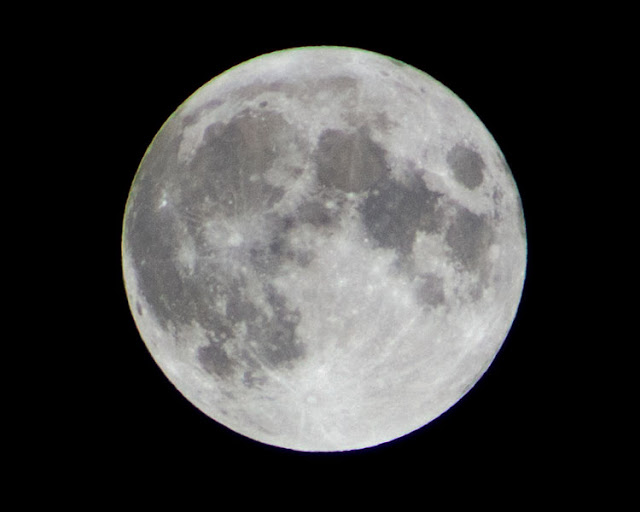 | |
|
Well, it was nice to get out and look up at the sky and try to practice getting some astro images, but it is also nice to get out and enjoy a meal out at some of our favorite places that offer patio dinning. Here are the Resident Astronomers enjoying some Jalapeno margaritas under the trees on the Rose Canyon Cantina patio. Nice! We even had some bluebirds come by and try to encourage us to share some chips with them.
 |
| Enjoying Jalapeno margaritas on the Rose Canyon Cantina patio (Source: Palmia Observatory) |
Yep, all of us, included the birds were glad to see us out and about on the patio!
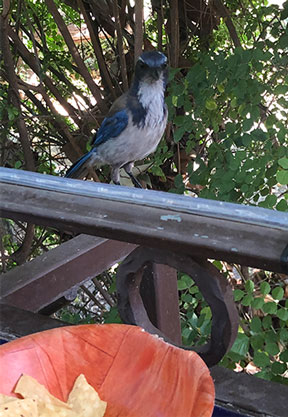 |
| Even the birds came to visit us on the patio (Source: Palmia Observatory) |
Until next time, here from our burrow, stay safe, as we recover more of our freedom,
Resident Astronomer George
Be sure to check out over 400 other blog posts on similar topics
If you are interested in things astronomical or in astrophysics and cosmology
Check out this blog at www.palmiaobservatory.com

No comments:
Post a Comment